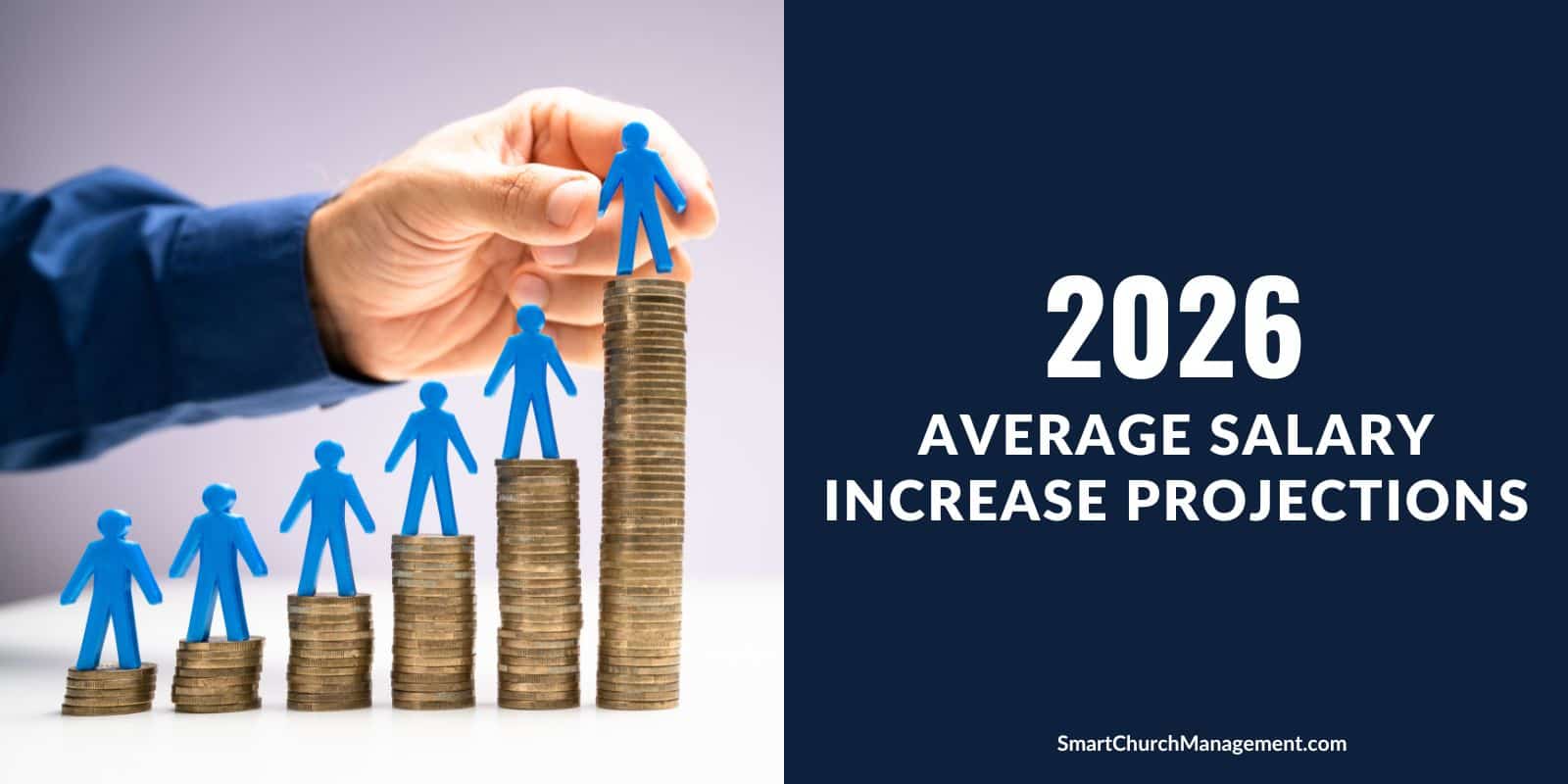Estimated reading time: 7 minutes
The end of 2025 is quickly approaching, and hopefully, by now, you have at least started talking about your 2026 church budget!
One fixed-cost budget line item is salary expense.
Churches with the resources to hire employees strive to have engaged employees by providing a great workplace.
One key indicator of engaged employees is competitive compensation. To keep salaries competitive, you will need to determine the annual salary increase.
Churches use personnel committees to help determine appropriate and fair compensation for church staff. And much of this work is done during the budgeting process.
Budget For Pay Increases
Church leaders often ask how much to budget for salary increases. If you are giving it your best guess, this can be a difficult decision.
However, a well-thought-out compensation strategy and sound budgeting practices ensure allocated dollars are used to reward employees for doing a good job.

Employers understand the importance of providing a competitive employee compensation package – and salary expenses are the biggest piece of the pie.
Hopefully, the following information will give you a conversation starter as you begin this important decision-making process.
These projections for the 2026 average salary budget increase will help you plan!
2026 Average Salary Pay Increase Projections
Inflation has finally started to stabilize. However, most continue to feel its impact.
It is projected that Social Security and Supplemental Security Income (SSI) beneficiaries will receive a 2.8 percent increase in 2026.
What The Private Sector Predicts For 2026
Many organizations use COLA to determine pay increases, but others predict percentage pay increases for 2026.
- As projected by SHRM, employees can expect an average base salary increase of 3.5% in 2026, the same as in 2025.
- According to a survey by PayScale, businesses are planning to maintain salary increases of 3.5 percent on average in 2026.
- Another comparison comes from World at Work, which predicts that the average pay increase for 2026 will be 3.6%, down from 3.8% in 2025.
A small percentage of organizations intend to give up to 4 percent increases in 2026.
Manage Worker Performance
Salary increases should be incorporated into a structured performance management system to reward and retain high performers.
The goal is to reward top performers with a larger share of the raise pool than poorer performers.
If employees perform well, they should be rewarded, but if they do not, there should be little, if any, pay increase.
Budgeting for raises should be part of the annual budgeting process.
This includes budgeting raise dollars and developing a system to award them to the best performers.
But how do you do that?
Let’s look at an example.
You want to award pay increases through a structured performance management process objectively.
This will require conducting annual performance appraisals and reviewing employee goal completion.
This information will help you identify and reward your best performers by allocating a higher percentage of the raise dollars to them and a smaller percentage to the lower-performing employees.
OK, let’s assume we have completed our performance appraisals and have the scores, but how do you tie those scores to raises?
Let’s go through an example. Let’s say (for the sake of easy math) that you have:
- 11 employees, each making $10/hour.
- Let’s also say that the church board approved a budget of 3.5 percent this year for raises. That 3.5 percent equals a pool of raise dollars of $8,008.
- You get this dollar amount by taking the salaries of those 11 employees and multiplying them by 3.5 percent (.035 x $228,800).
- The $228,800 comes from 11 (employees) x 2080 (hours) x 10 (dollars an hour) or 11 x 2080 x 10 = a salary budget for those employees of $228,800.
- Now, let’s also say you determined that average performance appraisal scores (3.0) will receive a 3.5 percent increase, and those scoring below average will receive less; those scoring above average will receive more.
Now, let’s look at what this might look like.
As you can see from the example below, there are 11 employees listed: a,b,c, etc.
The next column shows their average scores and an overall average score (3.4) for all employees.
In the next column, you can see the percent increase awarded to each employee based on the predetermined criteria.
Some employees received as low as a 2% increase. The higher performers received as high as a 4.5% increase, which translates into a raise of $416 for the poor performers. But more than twice as much – $936 for the higher-performing employees.
Now, if you total these increases, you’ll see that they’ll cost the organization $8,008, which matches what was budgeted.
Average Employee Scores and Percentage Increase
| Employee | Score | % Increase | Increase/hour | Increase | Budget | Difference |
|---|---|---|---|---|---|---|
| A | 3 | 3.5% | $10x.035=$.35 | $728 | ||
| B | 4 | 4% | $10x.04=$.40 | $832 | ||
| C | 3 | 3.5% | $10x.035=$.35 | $728 | ||
| D | 2 | 2% | $10x.02=$.20 | $416 | ||
| E | 3 | 3.5% | $10x.035=$.35 | $728 | ||
| F | 3.5 | 3.5% | $10x.035=$.35 | $728 | ||
| G | 2.5 | 2% | $10x.02=$.20 | $416 | ||
| H | 4 | 4% | $10x.04=$.40 | $832 | ||
| I | 4.5 | 4.5% | $10x.045=$.45 | $936 | ||
| J | 4.5 | 4.5% | $10x.045=$.45 | $936 | ||
| K | 3.5 | 3.5% | $10x.035=$.35 | $728 | ||
| Avg. Score | 3.4 | Total Raises | $8,008 | $8,008 | $-0- |
If you would like an editable copy of this scoring sheet as well as access to our growing library of forms, documents, and job descriptions, click here!
Keep in mind, this is an oversimplified example to demonstrate how to do this. Obviously, when there are dozens or even hundreds of employees, this scenario would look much different.
This process should benefit the good performers and serve as a wake-up call for the underperformers.
Employees who receive a less-than-average raise need to have a clear understanding of why they received the score they did – and how that affected their raise percentage.
Have a Conversation
It’s not an enjoyable conversation, but the organization owes the employee honesty.
It is also common to have a three-strike rule for performance appraisals.
If the employee consistently scores below average, they should either receive additional training, improve their performance, or be transitioned out of the organization.
Poor performers waste valuable resources. And when you are talking about paying salaries with church tithes, it becomes a stewardship issue.
Think about an employee who makes $25,000 a year, and you carry that under-performer for ten years.
That employee conservatively costs the church $250,000 for ten years. If you factor in a percentage increase each year, it is significantly more! You have to ask yourself, is that the best use of church resources?
Budgeting for raises should be an aspect of the annual church budgeting process and part of a strategy to achieve the organization’s mission.
Communicate Raise Decisions
Regardless of what is budgeted (or not budgeted) for raises, communicating with employees throughout the process is crucial to avoid surprises.
Employees need to know if raises will be available if they are meeting expectations and how raise distribution is tied to performance results.
If budget dollars are tight and raises aren’t available for next year, make employees aware of financial challenges. And get them involved in finding cost-cutting solutions.
What percentage are you budgeting for 2026 raises?
Learn More About Staff Evaluations
If you would like to learn more about raise distribution, please check out our book: Church Staff Evaluations: A Guide to Performance Appraisals
that Motivate, Develop, and Reward Church Employees
This book provides tools to make the performance evaluation process easier, as well as insights to help create a positive appraisal experience. To access this book, click here.
Access our library of forms, documents, and job descriptions by joining the SCM family!




